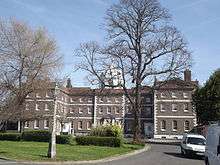Royal Naval Academy
| Royal Naval Academy | |
|---|---|
 Royal Naval Academy, Portsmouth | |
| Active | 1733–1837 |
| Country |
|
| Branch |
|
| Type | Training |
| Role | Officer training |
The Royal Naval Academy (1733–1837) was established at Portsmouth Dockyard as a facility to train officers for the Royal Navy. The founders' intentions were to provide an alternative means to recruit officers and to provide standardised training, education and admission.
Training
In 1733, a shoreside facility was established in the dockyard for 40 recruits. A comprehensive syllabus provided theoretical and practical experience in the dockyard and at sea. Graduates of the Academy could earn two years of sea time as part of their studies, and would be able to take the lieutenant's examination after four years at sea instead of six. The Academy did not, however, achieve the objective of becoming the preferred path to becoming a naval officers. The traditional means of a sea-going "apprenticeship" remained the preferred alternative. The vast majority of the officer class was still recruited in this manner based on family ties, and patronage. Family connections, "interest" and a sincere belief in the superiority of practical experience learned on the quarterdeck ensured that the officer class favoured the traditional model. William IV summed up this view when he remarked that "there was no place superior to the quarterdeck of a British man of war for the education of a gentleman".[1]
There was a clear prejudice against graduates. The then rating of midshipman-by-order, or midshipman ordinary, was used specifically for graduates of the Royal Naval Academy, to distinguish them from midshipmen who had served aboard ship, who were paid more.[2] After two years at sea, graduates of the academy were eligible to be promoted to midshipman.[3]
In 1806 the Academy was reconstituted as the "Royal Navy College" and in 1816 was amalgamated with the "School of Naval Architecture".[4]
The college closed as a young officer training establishment in 1837 meaning that from that date all youngsters setting out on a naval career proceeded directly to sea.[5] The closure of the college created a gap in officer training and in 1859 the wooden hulk HMS Britannia started to undertake the role of cadet training ship at Portland: in 1861 she was moved to the River Dart and continued performing that role at Dartmouth.[6]
Notable individuals
A distinguished Academy graduate was Philip Broke who attended the Academy in 1791. He achieved particular fame as Captain of HMS Shannon in its victory over USS Chesapeake in the War of 1812. Two of Jane Austen's brothers, Francis and Charles, attended the Academy in 1786 and 1791 respectively. Both went on to become Admirals.
Masters
- 1733–1740 Thomas Haselden, FRS
- 1740–1755 John Walton
- 1755–1766 John Robertson, FRS[7]
- 1766–1785 George Witchell, FRS[8]
- 1785–1807 William Bayly
- 1807–1838 James Inman as Professor of the Royal Naval College
Notes
- ↑ Dickinson 2007, p. 32
- ↑ Lewis 1939, p. 217
- ↑ Dickinson 2007, p. 38
- ↑ Hill, John R. and Bryan Ranft Eds. 2002 p. 251
- ↑ Dickinson 2007, p. 57
- ↑ Dickinson 2007, p. 66
- ↑ The British Society for the History of Mathematics
- ↑ Eclipse Maps
References
- Dickinson, H W (2007), Educating the Royal Navy, Routledge, ISBN 0-415-37641-6, OCLC 221337177
- Hill, John R. and Bryan Ranft Eds. (2002) The Oxford Illustrated History of the Royal Navy, Oxford University Press
- Lewis, Michael (1939), England's Sea-Officers, London: George Allen & Unwin, OCLC 1084558
- Roger N A M, The Wooden World, An Anatomy of the Georgian Navy, Fontana, 1988
- Kenedy G, Nelson K, Eds. Military education past, Present, and Future, Greenwood Publishing group, 2002